LIB 13.7%
Incumbent MP
Barry Haase, since 2010. Previously Member for Kalgoorlie 1998-2010.
Geography
North of Western Australia. Durack covers a majority of Western Australia’s landmass, stretching from the northern Wheatbelt outside of Perth, covering the coast all the way to the Northern Territory border. Major towns include Geraldton, Broome and Port Hedland.
History
Durack was created in 2010, out of northern parts of O’Connor and Kalgoorlie.
Kalgoorlie had previously swung between Labor and Liberal, and was held by the ALP’s Graeme Campbell from 1980.
Campbell was expelled from the ALP in 1995, and was re-elected in 1996.
Campbell lost to the Liberal Party’s Barry Haase in 1998.
Haase moved to Durack in 2010, and won a fifth term.
Candidates
Sitting Liberal MP Barry Haase is not running for re-election.
- Des Headland (Palmer United Party)
- Ian James (Greens)
- Melissa Price (Liberal)
- Shane Foreman (Rise Up Australia)
- Shane Van Styn (Nationals)
- Judy Sudholz (Citizens Electoral Council)
- Grahame Gould (Australian Christians)
- Ian Rose (Family First)
- Daron Keogh (Labor)
- Aaron Todd (Katter’s Australian Party)
Assessment
Durack is a safe Liberal seat. The Nationals were only 6.3% behind Labor in 2010. It’s conceivable that the Nationals candidate could overtake the Labor candidate in 2013, but the Nationals will still be a long way away from beating the Liberal Party. The Nationals will be helped out by the retirement of sitting MP Barry Haase.
2010 result
| Candidate | Party | Votes | % | Swing |
| Barry Haase | LIB | 32,446 | 45.07 | -1.00 |
| Shane Hill | ALP | 17,299 | 24.03 | -8.80 |
| Lynne Craigie | NAT | 12,742 | 17.70 | +9.67 |
| Julie Matheson | GRN | 6,661 | 9.25 | +3.32 |
| Jane Foreman | FF | 1,729 | 2.40 | +1.09 |
| Mac Forsyth | CDP | 1,121 | 1.56 | -0.32 |
2010 two-candidate-preferred result
| Candidate | Party | Votes | % | Swing |
| Barry Haase | LIB | 45,843 | 63.67 | +6.02 |
| Shane Hill | ALP | 26,155 | 36.33 | -6.02 |
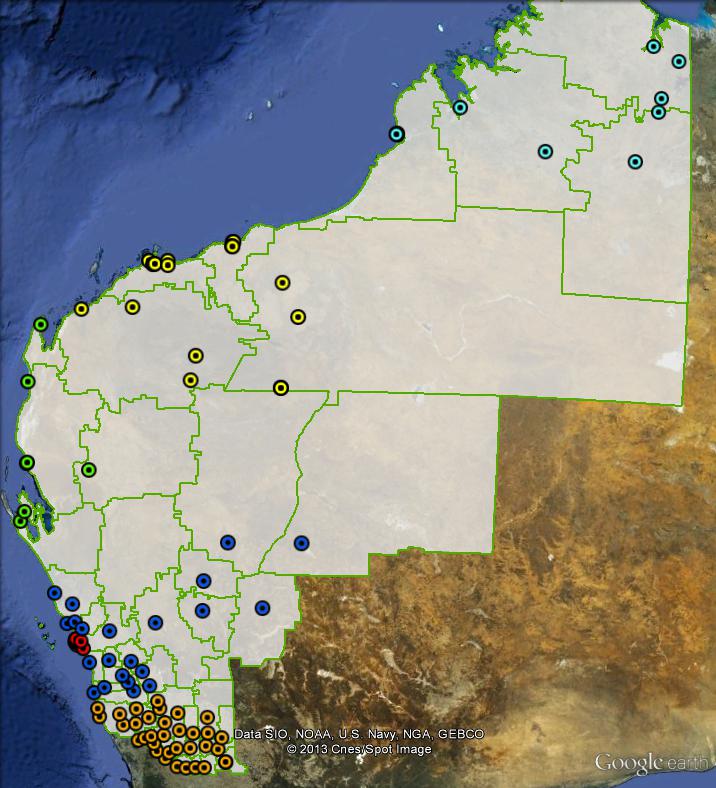
Booth breakdown
Booths have been divided into six areas. Those in the Geraldton urban area have been grouped together. The rest of the electorate was split into five areas. From north to south, these are Kimberley, Pilbara, Gascoyne, Mid West and Wheatbelt.
The Liberal Party won large two-party-preferred majorities in most areas, ranging from 62.5% in Geraldton to 71.5% in the Mid West. The Liberal Party won a relatively slim majority of 52.4% in Kimberley and 57.6% in Pilbara.
The Nationals candidate came third, with the Nationals vote varying from 13% in Geraldton to 27.9% in the Wheatbelt.
| Voter group | GRN % | NAT % | LIB 2PP % | Total votes | % of votes |
| Geraldton | 7.39 | 12.99 | 62.53 | 15,964 | 22.17 |
| Pilbara | 10.27 | 20.51 | 57.63 | 11,952 | 16.60 |
| Wheatbelt | 4.68 | 27.86 | 79.47 | 9,202 | 12.78 |
| Kimberley | 17.37 | 13.82 | 52.42 | 7,534 | 10.46 |
| Mid West | 6.19 | 19.71 | 71.45 | 6,428 | 8.93 |
| Gascoyne | 8.80 | 21.14 | 64.49 | 3,500 | 4.86 |
| Other votes | 10.38 | 14.96 | 62.35 | 17,418 | 24.19 |
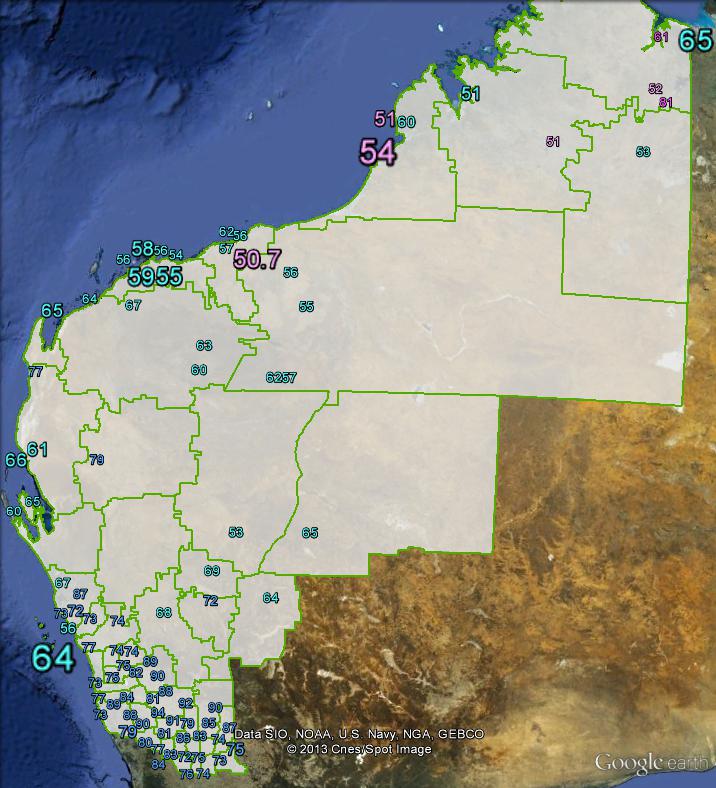
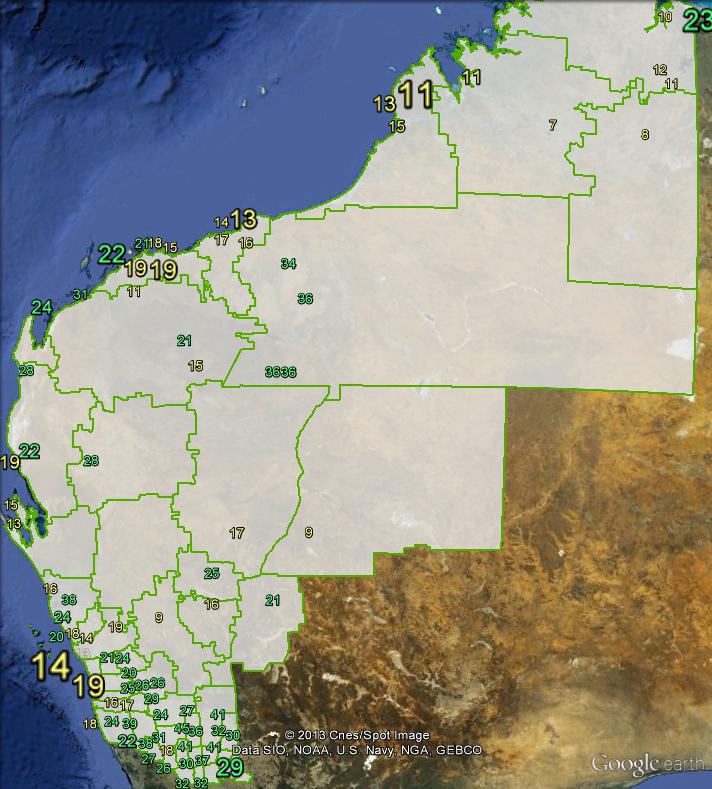
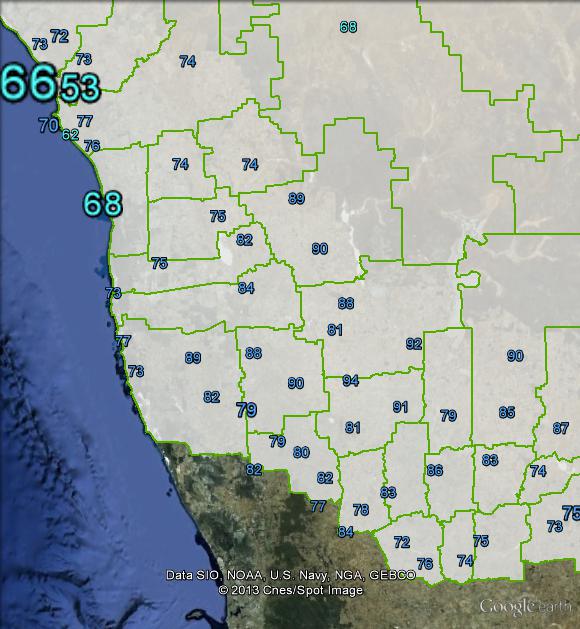
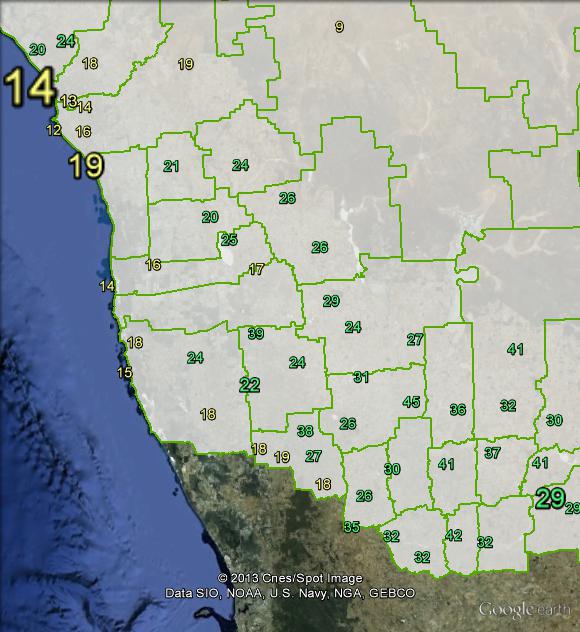
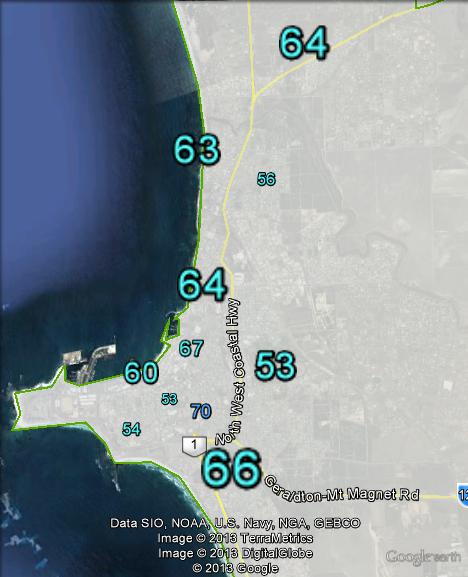
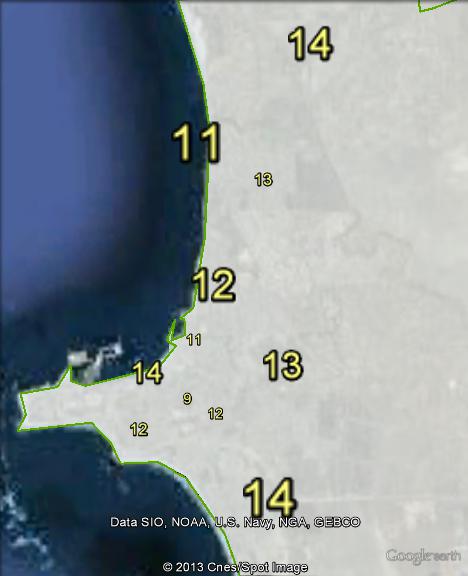


The ALP candidate is Daron Keogh
http://www.merredinmercury.com.au/story/1545330/labor-pre-selects-wheatbelt-local-for-durack/?cs=1478
Grew up in the eastern wheatbelt, now lives in Fitzroy Crossing. At least he’s been across the electorate. He’ll probably be able to keep Labor’s vote up in the Kimberley. The Greens might do quite well there as well – they damn near won the state seat in March due to James Price Point, in glaring contrast to their results everywhere else in the state.
If Durack was a country, it’d be the 19th largest in the world. It’s bigger than SA and only slightly smaller than Qld. How on earth do people campaign here?
My electorate, Labor will finish third, this will be a battle between Libs and Nats, Nats very confident given state election vote, most state seats in this electorate are Nationals with the exception of Geraldton and the Kimberley. Van Styn did well in the state election where he would have pushed Blayney in Geraldton if he had Labor preferences. Will be very difficult to defeat Hasse the sitting member although it could come down to who Labor and the Greens preference. Van Styn has unfortunetly made a couple of mistakes he was one of only three Geraldton councilers to vote in favour of deregulated trading which is a very divisive issue in Geraldton, would have been better off abstaining. Although I am hopeful of a Nats win I’m predicting a Liberal hold, will be game on when Hasse retires.
The liberals should not win majorities in the Pilbara or Kimberly and labor should have a better
vote in Geraldton………but the votes in the wheatbelt towns would still make it a non labor seat
Haase has withdrawn his nomination (proper news story to come, I suppose), so this is officially anybody’s seat. Looks like the Nats’ chances just got better.
https://twitter.com/mass_44/status/345879383598313473
Given since 2010 Labor cleared the way to industrialise the Kimberley (cite outgoing Resource Minister Ferguson) and approved a uranium mine East of Geraldton (cite Tony Burke) the Greens might gain an even better swing this time, but who is their candidate?
Wasn’t Shane Van Styn (Nationals) banned from operating a licenced premises in 2011 and fined $15,000 resulting in him handing over the business to his mother to keep it open? I suspect this blinkered electorate (yes I live in Durack) will vote for him in droves anyway.
Barry Haase retiring is no loss as he did nothing for Durack but deny claimte change, continuously rabbit on about live export, cane toads, and tree huggers, and he even claimed uranium ore was safe enough to handle with no gloves. The reason Haase only made it to minor shadow cabinet positions is because Canberra doesn’t take this area seriously. Perhaps a Greens or IND would have a better voice than yet another yes man.
You can really tell the 2010 Nats candidate was from Newman. Lynne Craigie is the East Pibara shire president, which explains the best Nats booths outside the wheatbelt being in that shire. The Nats got a huge swing in the Pilbara in March, but that was a high-profile campaign – their party leader swapping seats, and a long-term Labor MP retiring. I wonder how they’ll go federally there this time, with a lower-profile candidate from Geraldton.
Former AFL player Des Headland has been announced as Clive Palmer’s candidate here. Palmer also announces several other WA candidates in this media release
http://palmerunited.com/2013/07/palmer-united-party-western-australia-candidates-announced/
Has the Liberal Party named a candidate in Durack?
Apparently the new candidate will be chosen on Saturday.
Melissa Price is the Liberal candidate
http://www.abc.net.au/news/2013-07-14/durack-liberals-preselect/4819096
I wonder how the figures for this seat would differ if there was no FIFO-not much difference with this Labor government, but perhaps a Labor government of Hawke style competence would do much better in the northern parts of the electorate.
Ian James is the Greens candidate
http://www.abc.net.au/local/audio/2013/07/29/3813514.htm
Any insight from the west on Durack?
Odds for National party win have improved from $21 to $3 and the Libs have gone from $1.01 to $1.33. Accordingly, it appears that it Nat may be in with a real show? Given the Nats hold Northwest, Weatbelts (?), were second in Pilbra and did ok in Geralton(?) in the state election why haven’t they done better in the past?
Nationals just haven’t been very relevant at the federal level until Grylls took the leadership. Now they have O’Connor (whereas before they were struggling) and will get a boost in Durack with Haase retiring.
Pollster: your info is a bit out of date. (The Nats won Pilbara with a massive swing in 2013.) Durack mostly covers several state seats (4 Nat, 1 Lib, 1 ALP), due to remote WA seats getting to have less population than the average. I’ll run through ’em from south to north:
Central Wheatbelt: always been a rock solid National seat (preceded by Avon and Merredin, ditto). Full of wheat and sheep farmers, so no surprises there.
Moore (not to be confused with the federal seat) used to be a pair of Lib/Nat marginals until the one-vote-one-value redistribution. (It’s too much of a diversion to go into the Lib v Nat fights in this area in the 80’s, but there were some doozys.) Grant Woodhams (Nat) won Greenough from the Libs in 2005, then won Moore from them as well after the two seats were merged and both MP’s went head-to-head. He retired in 2013, and the Nats still won, personal vote be damned.
Geraldton: used to be a long-standing Labor seat (was even held by a premier) until the early 90’s when that Labor govt started falling to pieces. It was Liberal under Richard Court, but Labor again for the Gallop/Carpenter Labor govt (thanks to the local Lib MP’s corruption scandal, and One Nation preferences in 2001 always going against sitting members). The 2008 redistribution added bits of the old Greenough, so it became notionally Liberal and Labor lost it when they lost government. They crashed to third in 2013, which isn’t so much a good result for the Nats as a really bad one for Labor.
North West: Was won by Vince Catania for Labor in 2008. The Nats came a close third, and helped him win by their preferences not going to the Libs as strongly as you might expect. In the long, long 4 1/2 years between elections, (a) Catania defected to join the Nats, and (b) the seat was redrawn to give it a notional Nat margin. So in 2013, Catania won for the National Party. Karma will get him in the end.
Pilbara: this is the second of the three northern seats where the Nats first had a serious crack in 2008. They came second, and thanks to Liberal preferences came fairly close to unseating Tom Stephens, who represented the area in either lower or upper house of parliament for 30 years. In 2013, Stephens retired, and Grylls made his big push for the north by walking away from Central Wheatbelt and contesting Pilbara. He won with a huge swing.
Finally, Kimberley: this one was seriously weird. In 2008, the Nats got close to 20%, but not enough to get near the two-party count, so Labor won as usual. In 2013, the James Price Point gas hub was a massive issue, particularly in Broome. There was something close to a four-way tie, with ALP, Lib, Grn and Nat (in that order) getting between 26.7% and 18.4%. The Greens were actually looking like winning the seat in early counting, until Labor were saved by the mobile booth from Aboriginal communities. 26.7% must be fairly close to a record low primary vote for a winning candidate with compulsory preferential voting.
Erm, insights? State results would favour the Nats, but their new demographic up north is people who have recently swapped over from Labor. Federally, a lot of these folk dropped Labor not quite so recently, for the Libs. I’d call the Nats favourites, but it’s not such a sure thing as winning 4 state seats out of 6 might suggest.
And that’s a big post for a big seat. Sorry about the tl’dr, folks. 🙂
Thanks BoP. Really appreciate your big post for a big (half of Europe size) seat. Very comprehensive and insigthful for an easterner.
Conclusion, Nats must be a real chance here. They only need to get in front of the Labor party and one would think that they could get home on preferences assuming that the Lib vote falls from circa 45% to 40%. It would be interesting to know if David W’s positioning as #1 in the senate ticket will move some of the aboriginal labor vote in the Kimberly to the Nats.
PS: Accordingly to Antony Green the lowest winning primary vote was 16.6%. Extract from Antony’s post below:
“McMillan is an eastern Victorian electorate, mainly rural, but also containing some significant coal mining towns. At the 1972 election the Liberal Party chose not to re-endorse its sitting MP Alexander Buchanan, causing him to nominate as an Independent.
Labor’s Frank Mountford led the field with 45.8% of the vote, but he was opposed by four competing conservative candidates. New Liberal candidate Barrie Armitage had 24.1%, Country Party candidate Henry Arthur Hewson 16.6%, anti-communist DLP candidate Michael Houlihan 7.2% and the former Liberal MP Buchanan with 6.3%.
The remarkable victory of Hewson came about because the preferences of both Buchanan and Houlihan flowed strongly to Hewson, putting him ahead of the Liberal candidate, with Liberal preferences then electing Hewson ahead of Labor’s Mountford.
What is remarkable is that out of 18,721 ballot papers distributed as preferences, only 907 flowed to Labor’s candidate. The four competing conservative candidates had a very tight swap of preferences and ensured the Labor candidate did not win this conservative seat by default.”
It’s possible. Kimberley has had Aboriginal MP’s continuously for 33 years, all elected for Labor (although Ernie Bridge quit the party and sat as an independent for a few years in the 90’s), so the Aboriginal vote would be more solidly Labor at state level. Wirrpanda may help the Nats, and James Price Point may still help the Greens (they won the town of Broome in March). It’s a tough area to pick, and an area the Nats need to do better than the state election in if they want to win Durack.
Also, the CLP won a big chunk of the Aboriginal vote in the NT election last year, the main reason they won govt. I don’t know if that’ll be repeated, or whether it would help the Libs or Nats if it is.
Fracking is a much bigger concern now than in 2010, which could affect the vote. With ex-National leader Mark Vaile now Chairman of Whitehaven Coal and a supporter of strip mining agricultural land and fracking, I’d say current Nationals will not be drawing attention to that.
Shane Van Styn (Nationals) is an accountant and nightclub owner but has only called for an “inquiry” into fracking.
Ian James (Greens) is actually a farmer, opposes fracking and supports agricultural development of the north as a potential “food bowl”.
I doubt either will win but their preferences may be important.
What are the chances of the Nats here? They had lots of success during the recent state election, will it show on a federal level?
Bookies have them at $5 against $1.15 for the Libs. I can’t say I know much about this area, but the loss of a sitting member in a regional seat is always good for a swing.
Interestingly, the bookies rate Durack more likely to go Nat than O’Connor ($6/$1.10). What’s happened on the ground over there?
That seems rather strange. Especially considering that the state seats that cover the north are largely Labor (Kimberley) and Nationals (Moore, Pilbara and North West Central). Central Wheatbelt is a Nationals heartland
But the south of the seat seems to be reliably Liberal on 2PP.
Will be an interesting seat to watch on Saturday. If the Nationals can beat out Labor, this will be a fight.
No, it’s reliably non-Labor. Considering Labor came a distant third in the wheatbelt, the correct measure is Lib vs Nat. This area was transferred from O’Connor before the 2010 election, so the Libs lost the personal vote of Wilson Tuckey (who got a lot of votes in the wheatbelt from people who otherwise vote Nats), while the Nats candidate was from Newman, so neither side would’ve been favoured. For that reason, there probably won’t be as much of a Lib-to-Nat swing as in the southern wheatbelt, where Tuckey ran and lost in the continuing O’Connor in 2010.
Meanwhile, up north (the former Kalgoorlie), the Libs lose Haase’s personal vote, which should be good for the Nats, but their candidate is from Geraldton this time. And the Kimberley will be a wildcard… if the Greens get over 20%, like in the state election, it’ll confuse things further. I’ll tip the Nats, but not by much. (The one thing I am sure of: Labor will come third.) A seat this huge is always gonna be hard to read.
my complaint is how this outback seat and O’connor are drawn there is no community of interest
All of the wheatbelt should be in the one seat….
Could this be a stronger chance than O’Connor for the Nats – Haase announced retirement late cf O’Connor where RIck Wilson was chosen two years ago, and the electorate is not tarred by Tony Crook constantly siding with Labor
Mick, the previous Kalgoorlie / O’Connor alignment did that, but the problem was that Kalgoorlie was huge (Esperance and Kununurra are as far apart as Melbourne and Townsville, yet shared a seat), and that massive seat only bordered one other: O’Connor. That meant whenever Kalgoorlie was redrawn, it had to absorb wheatbelt shires from its only neighbour – in 2007, it contained Merredin (the main town in the eastern wheatbelt), and O’Connor was a weird hourglass shape. Further redistributions like that would’ve dragged the increasingly misnamed Kalgoorlie very close to either Geraldton or Albany, and pushed O’Connor into the south-west. The “community of interest” thing just wasn’t doable in the end.
‘Tony Crook constantly siding with Labor’? Didn’t he vote with Coalition 85% of time?